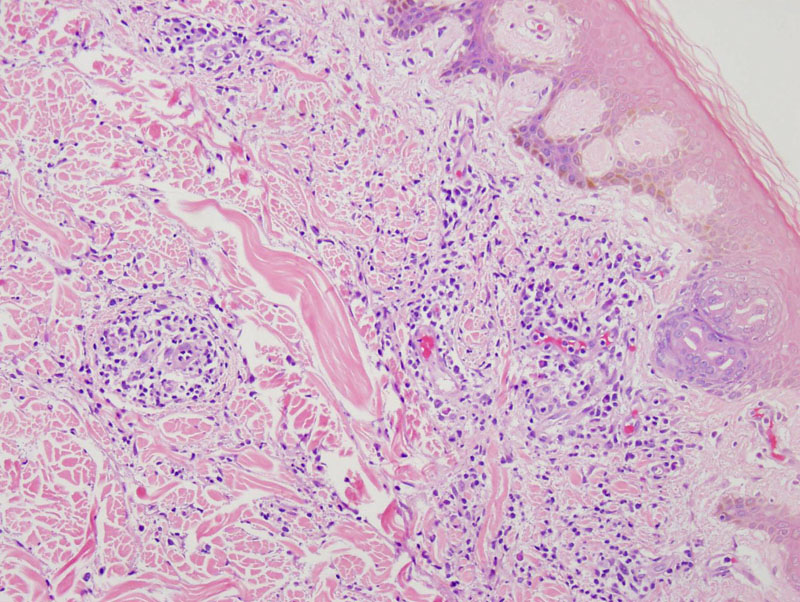

A relative dense infiltrate of lymphocytes and plasma cells occupies the superficial dermis. The histology of secondary syphilis is as variable as the clinical presentation can be. While not seen in this case, other cases may contain epidermal involement as well.
Distinct perivascular cuffing by the plasmacytic infiltrate can be appreciated. The endothelial cells are swollen. By contrast, examples of the nummular syphilides may contain many neutrophils.
A Warthin-Starry stain under oil 100x shows the spirochetes.
Secondary syphilis can be a great mimicker. Asymptomatic, scaly, red or flesh-colored plaques and papules are seen on the face and trunk. Copper-colored lesions on the palms and soles are common, as well as moth-eaten alopecia.
Relatively distinct microscopic features include swelling of endothelial cells in dermal vessels and a plasmacytic infiltrate. Spirochetes can be highlighted with a Warthin-Starry stain. In secondary syphilis, the epidermis can be normal, psoriasiform or ulcerated. A lichenoid lymphocytic infiltrate can mimic lichen planus. The presence of acanthosis and parakeratosis can mimic psoriasis (Sternberg, Rapini).
Primary syphilis presents as a painless lip or genital ulcer. Secondary syphilis can mimic a variety of skin conditions and the patient may have constitutional symptoms (e.g. lymphadenopathy). Tertiary syphilis presents as single or multiple plaques or ulcers (Rapini).
→Secondary syphilis is characterized by a dense plasmacytic infiltrate and swelling of endothelial cells.
→Other features include vacuolar interface change, a lichenoid pattern of inflammation, spongiosis, psorisiform acanthosis and exocytosis -- thus, mimicking a variety of skin conditions.
→A Warthin-Starry stain can help highlight the spirochetes.
Rapini RP. Practical Dermatopathology. Philadelphia, PA: Elsevier; 2005: 165-6.
Mills SE, ed. Sternberg's Diagnostic Surgical Pathology.4th Ed. Philadelphia, PA: Lippincott Williams & Wilkins; 2004: 14.